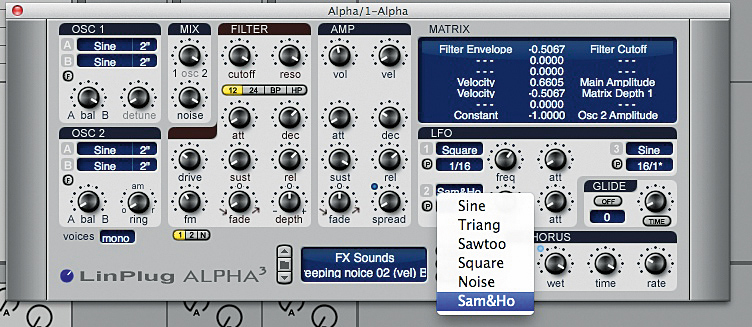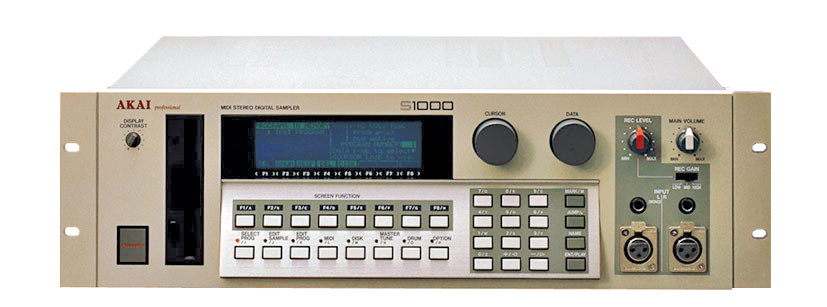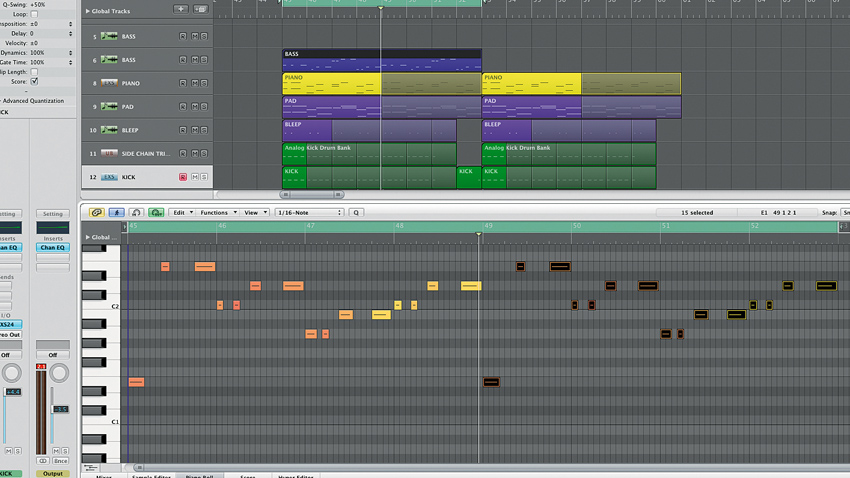The A to Z of computer music: S (part 1)
Sampling, saturation, sidechaining and more

Getting stranded by sonic speak? Take yourself back to school with our ongoing guide to the specifics of music production.
Sample and Hold
Usually abbreviated to S&H, Sample and Hold is a synthesis technique by which a 'snapshot' of an oscillator waveform is captured and 'held' for a period of time, then used to modulate another parameter - filter cutoff or oscillator pitch, for example. The oscillator used for S&H will very often be a random noise generator, making the sampled waveform particularly useful for the creation of old sci-fi soundtrack-style beeps and burbles.

Sample
Any digitally stored piece of audio can be considered a sample, but the word is generally used in relation to the short clips and loops used in music production, rather than full tracks. The act of sampling involves recording a sound into your computer via an analogue-to-digital converter (your audio interface) and using the resulting sample either 'as is' or processing and manipulating it into a whole new sound.
Samples can either be placed directly on audio tracks within a DAW, or imported into a sampler or sampling synth, where they can be played up and down the keyboard via your MIDI keyboard, triggered 'percussively' using a MIDI drum kit, etc. They can also be employed as 'one-shots' or 'loops', the former playing back only once when triggered, the latter cycling repeatedly until triggering or playback stops.
The advent of sampling was a milestone in music production history and, without it, dance music, electronica, hip-hop, drum 'n' bass and many other styles either wouldn't exist at all or would sound very different indeed. Today, there's a sizeable commercial market for pre-produced samples, with companies such as Loopmasters, Sample Magic, Zero-G and countless others pumping out packs of loops and one-shots to serve all musical needs imaginable, as well as lavishly produced multisampled instrument libraries that give the home-studio-based producer affordable access to astonishingly realistic virtual drum kits, orchestras, guitars, pianos and pretty much any other real-world instrument you care to name.
Sample Rate
When an analogue signal is converted to a digital one, the number of times a second that the waveform's position is captured and logged as a discrete digital value is called the sample rate. The higher the sample rate, the greater the range of frequencies that can be captured - some modern DAWs are capable of handling audio at a sample rate up to 384kHz (384,000 captures per second).
However, the average musician really needn't go beyond 96kHz at most. Indeed, the highest frequency that can be represented by a digital signal is half that of the sample rate - known as the Nyquist frequency - so with human hearing maxing out at around 20kHz, it's no coincidence that the sample rate for CDs (the original digital consumer format) is 44.1kHz. That particular rate ("CD quality") remains the standard for audio playback today, and it is able to store and reproduce all audio content perfectly within the range 0-22050Hz.
Get the MusicRadar Newsletter
Want all the hottest music and gear news, reviews, deals, features and more, direct to your inbox? Sign up here.
Another point to consider when selecting sample rates, of course, is storage space - every doubling of sample rate doubles the size of the audio file, after all.

Sampler
Once upon a time, a sampler was a physical device used to record and play back samples. Today, the hardware sampler is all but dead, replaced by more powerful DAW-integrated soft samplers, most of which are only used to play back imported samples rather than record them.
A sampler can be used to map related samples (a series of sampled piano notes, for example) across the range of the keyboard for pitched play, or to place discrete sounds (eg, the various elements of a drum kit or a collection of loops) on individual notes. As well as their position on the pitch 'axis', samples can also be mapped up and down the MIDI velocity range - eg, sampled gentle taps on a snare drum for low velocities, heavy hits for higher ones. Most samplers also feature a range of synthesis controls (filters, envelopes, LFOs, etc) for manipulating their loaded samples, as well as effects, mapping and playback options, and more.
Saturation
Saturation originally referred to the 'overmagnetising' of magnetic tape, resulting in overt distortion of the recorded signal or gentle 'warming', depending on how heavy-handedly it was applied. These days, the word is used to describe the subtle distortion of any valve, transformer or other circuit or stage through lightly overdriving it.
Although tape is no longer a feature of the average recording studio, and valves and transformers are becoming rarer, the unarguable benefits of saturation can still be had via the increasing number of plugins on the market that emulate them.
Scrub
The ability to shuttle playback backwards and forwards through audio at a user-controlled speed (either using the mouse or the jogwheel on a hardware control surface). Scrubbing is a software-specific feature (ie, not a universal one) that helps position the playhead precisely in applications that support it.
Semitone
An interval of half a tone on the western musical scale, and the distance between adjacent keys on a piano keyboard - F to F#, say, or B to C. An octave comprises 12 semitones.
Send/return
The send control on a mixer channel taps the signal from that channel and literally sends it to a dedicated 'return' channel, which is fed back into the mix. The main use for this setup (known as a send/return loop) is effects processing: with an effect (eg, a reverb) inserted into the return channel 100% wet, any number of source signals can be fed to it in varying amounts via their send controls, thus placing them all in the same sonic 'environment'.
Sequence
A series of MIDI or audio events in a DAW/sequencer is a sequence, and the act of creating such a series is called sequencing.

Sequencer
The definition has changed greatly over the years (and these days the word has been all but replaced by 'DAW' - Digital Audio Workstation), but a sequencer nowadays can be described as a software or hardware device for recording and editing MIDI - and often audio - and arranging it over time.
The earliest software sequencers were MIDI-only, with audio added later, but the concept is the same: sequences are recorded in real-time via a MIDI keyboard or other instrument, or programmed using the mouse and keyboard, then edited in terms of pitch, timing, velocity and various other parameters in a MIDI editor (piano roll, drum, event/list, etc).
Another popular form of sequencer, the step or pattern sequencer, can be found on many synths and drum machines, enabling non-realtime sequencing within their own interfaces.
Shuffle/swing
The shifting of every second note on a specified note-value grid (usually, that means every other 16th-note) to the right by an adjustable amount in order to apply an increasingly 'swung' or 'dotted note' feel to the rhythm. In software, the exact timing of any given swing percentage will vary, but the benchmark is still Akai's classic MPC series, the swing settings of which have been emulated time and time again by software.
Sibilance
The harsh, high-frequency "s" and '"sh" sounds that are inherent in any vocal performance and often need to be reined in as part of the mixing process. Just EQ'ing out these frequencies will make the whole vocal sound dull, so frequency-conscious compression is the solution.
This can either be applied via a compressor with a sibilance-boosting EQ inserted into its sidechain input, or a dedicated de-esser plugin, either of which essentially do the same thing: reduce the volume of the vocal when sibilant frequencies are detected. Some smarter de-essers will attenuate only the sibilant frequency range.
Sidechain
A secondary input on a compressor or gate into which a separate signal to the one being processed can be fed and used to control the action of the compression or gating. The classic example in modern music is the rhythmic pumping effect created by sidechaining a bassline or pad sound (or even a full mix!) with a 4/4 kick drum, but sidechaining is also useful for de-essing vocals (see Sibilance) and general 'ducking' (lowering in volume) of any sound to make room for another sound occurring at the same time. A sidechain input is a common feature among today's dynamics plugins.
Slope
The slope of a filter determines the 'steepness' of its response curve. So, a 12dB/octave slope reduces the volume of the signal by 12dB for every octave it extends beyond the cutoff frequency in the direction established by the filter type - above for a low-pass, below for a high-pass. Higher slopes give more 'brutal' filtering, while lower slopes give a more natural sound. Most filters offer a choice of slope - usually 6, 12 and 24dB/octave, some including an 18dB option and a few sharpening up to 48.
Slope is also described in terms of the number of 'poles' of the filter, each pole contributing 6dB/octave of attenuation - a 4-pole filter, then, has a 24dB/octave slope.
Snap to grid
With a DAW's snap to grid function enabled, any action that changes or establishes the position of an event or events (inserting, moving or slicing of clips, MIDI notes, automation data, etc) on the timeline will result in that event(s) automatically aligning with the quantise grid (set by the user), rather than the actual position of the mouse pointer. With snap enabled, dragging an audio clip into a project and placing it between two gridlines will see it jump to the nearest one.
Computer Music magazine is the world’s best selling publication dedicated solely to making great music with your Mac or PC computer. Each issue it brings its lucky readers the best in cutting-edge tutorials, need-to-know, expert software reviews and even all the tools you actually need to make great music today, courtesy of our legendary CM Plugin Suite.










